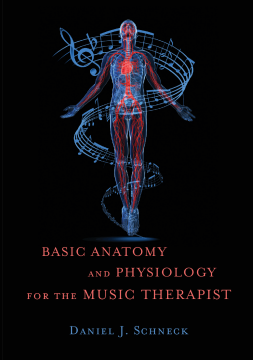
Additional Information
Book Details
Abstract
Providing need-to-know information about the human body for music therapists, this book covers the elements of anatomy and physiology that are of particular relevance to clinical practice.
Addressing both the structure and function of the human body, the material is presented with the music therapist in mind. Particular attention is paid to the role of music in affecting responses from the organ systems, including the senses, the endocrine glands, the immune system, the musculo-skeletal system, the nervous systems and the vestibular system. Dr Schneck also uses accessible musical metaphors to explain complex biological information.
Emphasising the symbiotic relationship between music and the body, this book reveals how an understanding of this relationship can help music therapists to practice more effectively, and will be of interest to students and practitioners alike.
Dr. Daniel Schneck's Basic Anatomy and Physiology for the Music Therapist is an important addition to the literature in the profession of music therapy. This book is specifically oriented to the needs of the practicing clinical music therapist by emphasizing anatomical/physiological principles, which are deeply influenced by the energetic elements of music - rhythm, melody, harmony, timbre, dynamics, and form - and the intricate relationships within and between them and the human body. Dr. Schneck explores in depth the mechanisms involved in human functioning and the processes involved when music interacts with the complex "living machine" that is the human body. This is vital information for the practicing music therapist to insure effective music therapy treatments and interventions. I highly recommend this book to professional and student music therapists. It represents the next level in the advancement of music therapy practice.
Barbara J. Crowe, MM, MT-BC, Professor Emeritus, Arizona State University Music Therapy Department, USA
Daniel Schneck has the tremendous advantage of being both a scientist and a musician. This book draws on his experience as a performing violinist, a doctor and a teacher. I have had the pleasure of working with him in his capacity as violinist when I was Music Director and Conductor of the Roanoke Symphony and can testify to his skill and musicality. I am filled with admiration for his commitment to the field of music therapy, as he is uniquely qualified to lead this rapidly-evolving area, and his book is organized and well written. He draws from Aristotle, Plato and Shakespeare to illustrate his points, and his ability to teach makes this a rewarding read.
Victoria Bond, musician and former Music Director of the Roanoke Symphony Orchestra, VA, USA
Knowledge of anatomy and physiology is essential for music therapists. Since Schneck is an accomplished musician and has collaborated with music therapists for years, he explains what humans are and how humans work in a comprehensive fashion, and directly relates it to music therapy. This unique presentation of anatomy and physiology not only looks at the mechanics of human life, but also at the emotions, spirituality, and search for knowledge that drives us as humans.
Janice Lindstrom, MA, MT-BC, Music Therapy Clinical Training Supervisor, Southern Methodist University, TX, USA, and Host and Producer of The Music Therapy Show, HeartbeatMusicTherapy.net
Beneath the unassuming title of this book lies a vast wealth of information about the human body, how it works, and how it is influenced by sound and music. From an atomic scale of anatomical organization through to the entire living human being as an integrated whole, Schneck provides us with essential and intriguing facts and observations relevant for every music therapist, intern, and student.
Robert E. Krout, EdD, MT-BC, Professor and Chair, Music Therapy Department, Southern Methodist University, Dallas, Texas, USA
Dr Daniel J. Schneck was a Fellow of the American Institute for Medical and Biological Engineering and the Biomedical Engineering Society. He published widely, including 24 books, and was a National Book Award nominated author. He was an international consultant on basic physiological function and the role of music in human adaptation. He was also an accomplished violinist and performed professionally. He was based in Virginia, USA.
